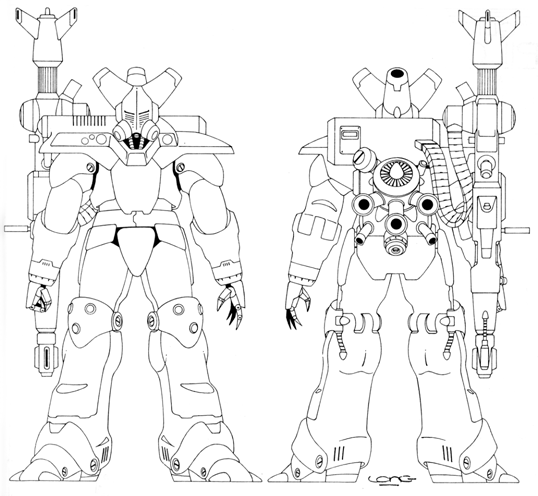 Vulpesveritas, on 02 August 2012 - 06:45 AM, said:
Vulpesveritas, on 02 August 2012 - 06:45 AM, said:
Now, while it is armored heavily, there is the point that it has no stealth capabilities or healing capabilities (except for the medical prototypes never deployed.), unlike a Nanosuit. A nanosuit operator is going to largely be taking a stealth approach anyhow, and through usage of anti-tank munitions and cloaking, could readily destroy an enemy group of T-51 equipped soldiers. Furthermore given the healing capabilities of the nanosuit and that they are made to take the same weapon fire as a soldier wearing a T-51 would be wearing, you would largely see the nanosuit users using hit and run tactics to great effect.
The Chinese had their own armor which was the Black Ghost Stealth Armor. Just from my personal experiences, the Nanosuit stealth mode seemed inferior. I was never impressed with the Nanosuit's stealth abilities. At least in the first Crysis (didn't like the sequel enough to purchase) I found it very easy to detect even without looking. Giving off a distinct sound and, to be honest, not stellar visual effects it was often a liability. I learned this quickly when I was counter-ambushed by experienced players. I thought I was doing it wrong, but after playing for some time with the vets of my unit I learned the quite obvious tells of the mode. With viability limited to only select scenarios while hemorrhaging energy (even while motionless), the same energy which powers your shield, strength, and speed, it is largely useless. Now my experiences are limited to earlier versions of the suit, but the energy issue I know has not changed.
Meanwhile in the Fallout universe, American Power Armor equipped soldiers have faced the Chinese stealth soldiers who have
at least equal visual concealment with no penalty of energy a completely silent system. These elite soldiers were known for their guerrilla tactics. The T-51 operators will be prepared for hit and run strikes using this technology.
As for healing and anti-tank munitions. Healing doesn't make a difference if the user is already dead does it? Nanosuit operators are not exactly durable. Outside of defense mode they are highly susceptible to conventional small arms fire. When activated defense mode certainly increases survivability, however the user is still vulnerable to 7.62x51mm, 6.8 SCP, 5.45x39mm, and even pistol cartridges. Any advantage they use will drain their energy as well, further weakening defense mode if reengaged without regeneration. Sure the suit can heal the user, however even at full health Nanosuit users are relatively fragile, even to medium caliber small arms.
This brings me to my next point: Armaments. As far as I can tell they two have very similar options when it comes to weapons. While I do not think T-51s were intended to carry assault rifles as their primary weapons, they certainly can. Also, even though Nanosuit operators seem more at home with traditional infantry style weapons, they can manage larger weapons such as chain guns. Both have man portable tactical nuke systems (although T-51s have the MIRV, it is experimental and thus not qualified as standard issue), Gauss rifles, etc. The only difference I see is that Nanosuits are slowed down by the weight of these heavier weapons. Hell if I remember correctly you walked slower with a lowly shotgun equipped.
T-51s were not designed for just defensive gain, but as a weapons platform capable of carrying normally unwieldy weapons systems through enhanced strength. Nanosuits may be able to field the same weaponry, but in exchange for a solid hit to their speed. With this it would be much more difficult to conduct hit and run missions unless the heavy weapons are abandoned or stashed after the initial strike. In a toe to tow fight. T-51s have the advantage in armor, and now in movement as they are unhindered by the large weapons they were designed to wield. Nano suits could still use speed mode for a short burst, but this again brings up the problem of energy making them vulnerable defensively.
 Zakatak, on 02 August 2012 - 02:53 PM, said:
Zakatak, on 02 August 2012 - 02:53 PM, said:
Well, it was specifically stated in canon that the chest plate of the T-51b is capable of absorbing 2500 joules of kinetic energy without being punctured. The 7.62x51 NATO round has a muzzle energy of about 3800 joules, and will reach 2500 joules at around 750m or so. It will protect you from any modern assault rifle or pistol (besides maybe a .500S&W), but anything as big or bigger then a battle rifle and you are punching through flesh. Just because power armor has replaced tanks doesn't necessarily mean it can match a tank, it is just alot more flexible and cheaper to produce.
I dunno. I like the T-51b, but it seems more like MJOLNIR armor without the shields or the ability to run 70kph+.
Now for this can of worms (not your post, the data provided by the wiki). It does indeed state 2500 joules which is the one piece of information which does not fit. The exact wording is “over 2500” but even so I find it odd that they would undercut the maximum value by so much. I saw this as well when I did my initial sanity check on my post, and it caused me to do some research as well. Of course assuming 2500 is the exact amount the plating is capable of absorbing, no the armor could not stop anything stronger than the standard load powder and slug weight of the 7.62x51mm round.
However, I believe this would assume a perfectly perpendicular impact. Of course like any good mechanized armor, the vast majority of the surfaces are curved to prevent this. If the impact is glancing, the armor will survive a 7.62 round and above, depending of course on the angle of impact. This still does not match the statement of defeating all small arms fire and even anti-tank munitions.
After looking into the source of the 2500 joules claim, I found that it came from the Fallout 1 item description. This may explain the vague description of the armor's capability as the description may have come from post war testing where resources were limited. Or it could be an easy catch-all way of describing the armor. Or it could have no grounding to real world physics and just used because it sounds cool. Honestly, I don't know. I choose to believe the lore over in game content, so I will maintain my stance. The armor was supposed to be revolutionary, and I do not believe that such a game changed would fail to stop common battle rifle rounds. The topic is debatable, but that is my view.
I am having a hard time finding the actual capabilities of Spartan-IIs and MJOLNIR. The only experience I have this them is in game as I have not read any of the books. Obviously they are toned down in game as I know in the lore the armor would shatter the arm of an unmodified human if used, but in game fails to kill a grunt if punched in the face. Because of this I do not feel I have the knowledge to judge the system compared to T-51s, however I am reasonably sure it it would be much more even than T-51 vs Nanosuit.
I don't mean to hate on the Nanosuit, but I do not think they even belong on this list. Everything on here is mechanized infantry. Nanosuit operators are Delta Force (Crysis 1) or other special operations forces. In other words highly specialized infantry. They are exceedingly effective against traditional infantry and light armored resistance, but not suited for front line slug fests. It is not what special forces do.
If we had a "Best Deniable Ops Soldiers" or similar thread I think they would be more at home and likely top contenders.
And to all of you not involved in this tangent conversation, thanks for the patience

 Highlander IIC, on 01 August 2012 - 07:35 PM, said:
Highlander IIC, on 01 August 2012 - 07:35 PM, said:



















